The Domino Effect: Pandemic Impacts to Higher Education that will Ultimately Reach PCO
For the past 15 months, colleges and universities have had a difficult time looking beyond the everyday issues on their campuses as a result of the COVID-19 pandemic. Past predictions and forecasts are no longer relevant as a result. To financially survive the pandemic, colleges and universities had to quickly embrace and deploy different technologies, which are the strengths of their professional, continuing and online (PCO) education units (as well as corporate providers) in delivering secure, remote learning. In fact, according to a recent UPCEA survey, 70% of PCO units indicate that they are viewed as more or significantly more valuable to their institutions as a result of the pandemic.
PCO units can help their central administrations look beyond the day-to-day issues and plan for the future, as the disruption of K-12 is likely to create many pathways to learning. The impact on K-12 will create a greater need for safety nets as students earn credentials and ultimately enter the workforce. The lack of readiness of K-12 (no fault of theirs) has created a number of problems and opportunities for higher education, including:
- The pandemic highlighted a myriad of failures in the K-12 system, leaving some students unprepared or unsure of themselves.
- There is talk that some K-12 students may retake courses (or even an entire year) and delay college or entry into the workforce.
- Many academically-unprepared students will be passed on to colleges and universities or directly to employers.
- Some college-ready students may permanently bypass higher education or postpone their education.
- In general, failures across K-12 have been disproportionate. Figure 1 shows that disproportionate failures have affected low-income and underrepresented students at an exponential rate, compounding existing gaps and persistent achievement disparities.[1]
- This exacerbated a digital divide that will continue to trickle through higher education and enter directly into professional and continuing education units.
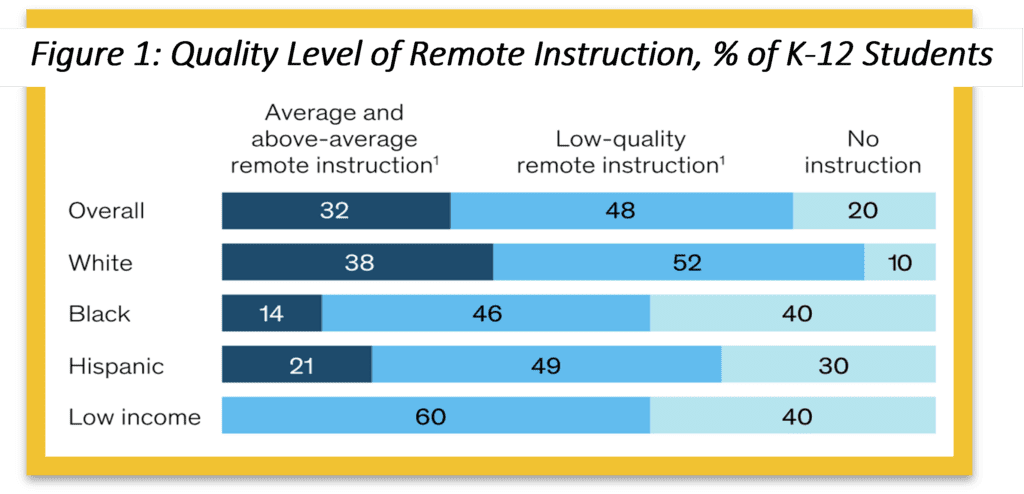 With K-12 in flux, traditional students are not as prepared to enter higher education compared to previous years of students; with some experts saying that K-12 students may be up to a full year behind in math.[2] High school juniors and seniors may also be questioning the return on investment for higher education, which will accelerate the popularity of new and nontraditional educational pathways.
With K-12 in flux, traditional students are not as prepared to enter higher education compared to previous years of students; with some experts saying that K-12 students may be up to a full year behind in math.[2] High school juniors and seniors may also be questioning the return on investment for higher education, which will accelerate the popularity of new and nontraditional educational pathways.
Thus, one ‘educational failure’ domino is hitting the next, creating a domino effect that could weaken the education system at large if we don’t act quickly.
In the chaos caused by COVID-19, each state employed a different approach for K-12 public education: some re-opened to in-person classes, some adapted a hybrid system, and some stayed the course with distance education. At the start of 2021, more than 12 million K-12 students were digitally underserved.[3]
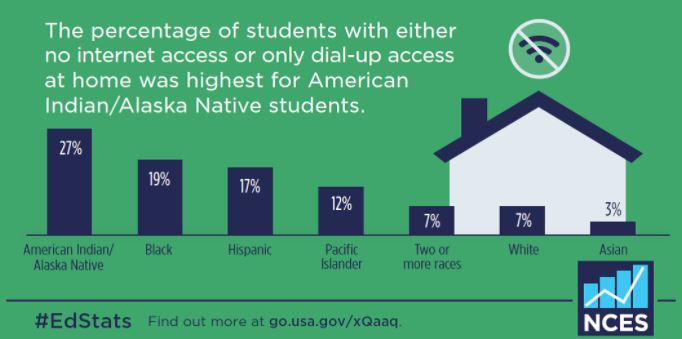
Figure 2: Percentage of Students with No Internet Access | Source: National Center for Education Statistics (7.2020)
The majority of these digitally underserved students come from communities of color and/or low-income households.[4] A report published by McKinsey & Company in 2020 found that “only 60 percent of low-income students are regularly logging into online instruction; 90 percent of high-income students do.”[5] The National Center for Education Statistics reported that Alaska Native and American Indian K-12 students were more likely to have struggled with either no internet access or only dial-up access at home during the pandemic, shown in Figure 2.[6]
Since distance learning was mandated for months in many states, students have already missed a lot of school and are therefore more likely to drop out, especially those who are dependent on the structure and supports of school.[7] Since there is a decrease in education quality and engagement, schools have been forced to lessen graduation requirements, even with the consequences of less skilled students and workers in mind.[8] The weakened high school graduation requirements are causing greater variability in student readiness for college and may even cause an increase in college dropout risks.
These failures ultimately caused the first domino to fall.
The force of this initial domino falling will soon be felt, while we are also just starting to see the signs regarding preparedness and the effects of declining mental health and limited socialization.[9] Looking ahead, I anticipate seven specific ripple effects from the first falling domino.
- We are likely to see an enrollment rollercoaster
Institutions were already grappling with enrollment challenges. The COVID-19 outbreak compounded those challenges as both current and prospective students rethink whether, when, and where they should attend. One potentially false metric in the marketplace is the increase in applications. Colleges and universities have been optimistic that they will survive the pandemic as many have seen increased applications. In the absence of SAT scores as a criteria for acceptance, students applied to more “reach” schools. The demographics of 17 and 18-year-olds does not support an enrollment recovery.
- We are likely to see a surge in demand for online adoption as an alternative
The switch to remote learning has delivered a rapid education – for faculty and students alike – in the technology and design needed for successful online learning. Even if many will be relieved to return to in-classroom learning, the question remains: after the crisis abates, will the lines between “online” and “in-person” be forever blurred? If anything, traditional classroom learners have been immersed in learning online for the past 12-14 months.
- We are seeing widespread financial instability
Increased competition, burgeoning debt and growing compliance costs have created fiscal challenges for many schools. Stimulus funding is but a drop in the bucket of what institutions need to cover their costs associated with COVID-19. Some experts predict that up to 20 percent of institutions are at risk for closure. Many institutions, pre-pandemic, were operating from less than stable financial foundations. When the dust settles for fall enrollments, it is unlikely that finances will improve for these already struggling institutions.
- We will need a more fluid, frictionless, and engaging student experience
Many four-year institutions have relied on physical facilities and amenities to foster student community (i.e., lazy rivers and climbing walls). Now, in order to differentiate, schools must find ways to attract, engage and retain students – digitally. A major criticism of students forced to be online, as opposed to the classroom, was that the instruction wasn’t engaging, exciting or what they paid for. Moving forward, institutions that are able to overcome mundane online instruction by developing new, interactive experiences to learning may see economic stability more rapidly than others.
-
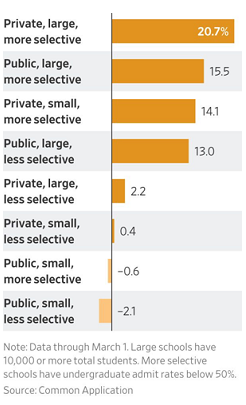
Figure 3: Percentage Change in Common Applications Submitted, 2019-2020, 2020-2021 | Source: Wall Street Journal (3.2021)
We are going to have IT as a critical mission partner and not just an afterthought
IT has enabled staff to work remotely and classes to continue, solidifying its place as a core collaborator in delivering the mission. Connectivity between the institution with students and faculty with students will be foundational to future online education. Investments will be needed to not only create a secure learning environment, but also to improve the learning experience and engagement between different stakeholders.
- We will need to prepare graduates for migration to an elastic workforce
Institutions are learning that successful remote work takes more than technology. It also requires a culture that empowers people to do their jobs remotely and to build the skills they need in this new world of work. Not only will content knowledge be critical in a new economy, but having the skills to work in a flexible environment will be equally important. A new hire would learn the company by being in the office and through mentoring from other staff. These dynamics will change in the new economy.
- Content will change, but so will the credential and dependence on degrees
For the past decade, downward pressure on tuition and rising operating costs have fueled conversations about radically rethinking higher ed business models. That conversation just got louder – and more urgent. What business models are scalable, cost effective and accessible enough to meet the needs of this decade and beyond? The role of business and industry in setting curricular needs is likely to grow. Not only will human resources and a chief online learning officer play a role, but we are likely to see more advisory committees in higher education helping to shape curriculum.There will likely be radical business model transformation. Colleges and universities are going to need to diversify their academic portfolios. Degrees will always play a role, however, alternative credentials and a stackable approach to education are likely to be in higher demand.
We will soon see how these predictions play out once the dust settles. But these predictions are just the beginning of the fundamental changes expected to ensue. Some higher education institutions may be wary of these ominous predictions after receiving record high applicants this past year. Inside Higher Ed recently reported that newly released data about the Common App show that what has been reported anecdotally in admissions is actually occurring in large numbers.[10] More specifically, the University of Virginia drew a record 48,000 applications for the next class in Charlottesville, about 15 percent more than the year before.[11]
However, despite many institutions receiving a record high number of applicants this past year, and the world beginning its return to “normalcy,” these indicators are misleading. Applications do not necessarily correlate with enrollments. Application increases at elite and large colleges will not translate into higher enrollment numbers. These colleges’ enrollment totals are not growing. Institutions are likely to have less students in the fall and those that do attend are going to be more vulnerable and potentially less ready.
However, this is dichotomous across larger and smaller institutions. Figure 3 shows that larger and more competitive colleges and universities are having a good year and getting lots of applications while smaller and less competitive colleges are not.[12] And first-generation students and those who lack the money to pay for an application are not applying at the same rates they used to. According to an Inside Higher Ed article, “…the [SUNY] system [reported] that [it] had seen an application decline this year of ‘20 percent, one of the largest annual decreases in the system’s 73-year history.’” [13] The growing pains of the pandemic are being felt to varying degrees across the industry, with an increasing burden on non-elite schools.
We are seeing the need to diversify revenues and the ripple effect of the pandemic, as well as the complex demographic coming into play. With less students, many are applying to more, larger schools. Many of these larger schools are seeing a false shadow. On the other hand, many other schools are suffering. We in higher education need to be prepared for this distinction and help these institutions through or we will witness a mass exodus and industry-wide consolidation.
As we enter the post-pandemic period, institutions across all levels should re-evaluate the system failures of the past year to better prepare for what is to come. Higher education is not out of the woods with respect to the pandemic’s spillover effects. Catastrophic shifts will begin to unfold in response to improve the faults made apparent during the pandemic. These paradigms will take years to truly unfold, but these movements have already begun.
As the pandemic caused many of us to pause and reevaluate, millions of students across all levels began to question the value of their education. Students began to consider other options. With rampant financial instability, diminished accessibility, and general pandemic-related uncertainty, cracks were largely exposed in the national education system across all levels. While these cracks were revealed, continuing education units began to expand and capture additional value.
While the pandemic has run its course, and chaos has ensued among higher education institutions, more traditional age undergraduates have been entering PCO channels. InsideTrack and UPCEA have conducted annual surveys to understand enrollment trends. Looking at the 2021 data, traditional age students (18-21) and young people (22-24) are enrolling in graduate certificates and graduate degrees at higher rates this past year than in 2019. This indicates a shift in where enrollment numbers for continuing education units may be coming from and even where enrollments for higher education institutions are shifting towards. The study also found online program satisfaction has decreased slightly from 2019 to 2021. In 2021 68.3 percent are extremely (26.9%) or very (41.4%) satisfied, while that percentage was 73.3 in 2019 (26.8% extremely and 46.5% very).
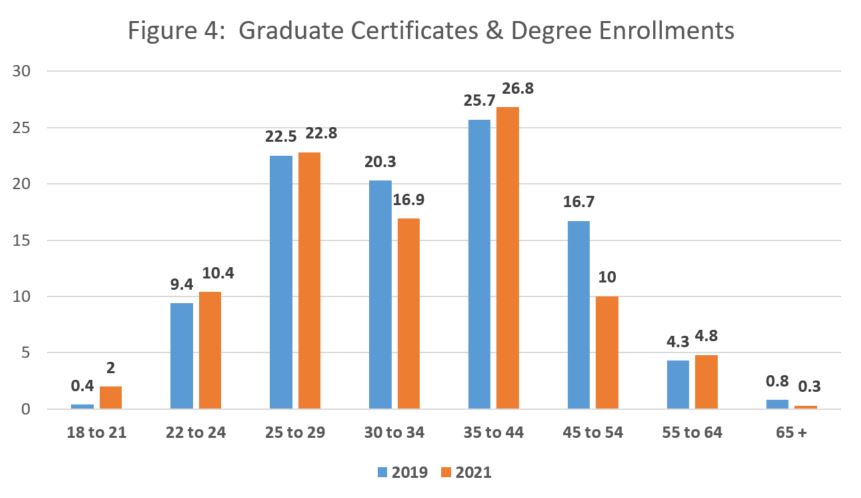
Source: InsideTrack & UPCEA, 2019 & 2021
Also, in February 2021, individuals from 54 institutions took a brief survey on the effect of the pandemic on their PCO units in 2020 and beyond. Invitations were sent out via UPCEA’s Membership Matters newsletter and a link was also posted on UPCEA’s member community, CORe. As a result of the pandemic, 38 of the 54 respondents (70%) noted that the PCO unit at their institution has become more or much more valuable.
I anticipate PCO units will continue this trajectory as student preferences shift. These units will take on a larger role amongst higher education institutions as the system grapples with how to provide students with high quality education that is increasingly flexible and customizable. The anticipated fallout among the respective K-12 and higher education systems will persist even as the pandemic comes to a close, precipitating the growth of PCO. The spillover effects from the pandemic will continue to be felt and may lead to a rebirth in the role of PCO units.
The hemorrhaging of K-12 and higher education systems has disrupted the quality of education students have received. Because of this breakdown, this generation of students will not be prepared in the same fashion as previous students in their educational journey. This lack of preparation will continue to snowball as students continue their pursuits through the educational food chain. It is anticipated that an increasing number of students will drop out across education levels. Factors such as confidence, financial stability, and self-direction catalyze students to forgo traditional education pathways through K-12 and higher education. Thus, the traditional structure of the education system lacks the adaptability and resources necessary to provide students of all diverse socioeconomic backgrounds with the tools needed to become successful post-grad. As a result, higher education will likely see a re-emergence of baccalaureate degree completion. Given the struggles of K-12 over the past 14 months and potentially longer, some students entering college may drop out and need a place to reconnect. This reconnection could take the form of baccalaureate degree completion later down the road. It will be incumbent upon colleges and universities to regain their own lost students, however, students that drop out may seek a fresh start elsewhere carrying their previously earned credits with them.
PCO units may be leveraged more within higher education institutions to provide students with the assistance they need via modern educational pathways that support student success, even when they fail. Pathways may be developed that leverage non-credit and for-credit opportunities that can feed into each other to keep students on track, even when they face previously insurmountable obstacles. The flexible nature of PCO programming through its online delivery and affordable price-point, align with preferences of younger generations, Generation Z and Millennials, who are becoming a larger segment of PCO enrollments.
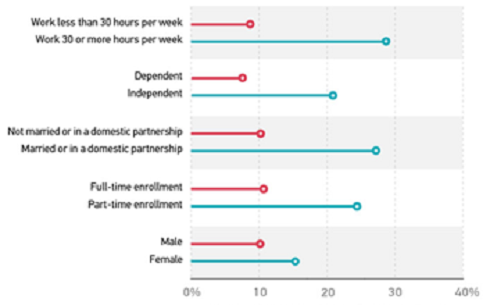
Figure 5: Percentage of Students Who Prefer a Mostly or Completely Online Learning Environment | Source: EDUCAUSE (5.2020)
Another potential driver is the “new commuter.” One distinctive feature of traditionally defined commuter students is that they, like traditional adult learners as they are defined, like the face-to-face and had fears of technology and online learning. The pandemic may have been one big, gigantic training session for them. They may go back to the classroom once things settle down, but they may have new confidence or at least a willingness to shop for value. In the least, they have more choices and we have more competition amongst each other. Figure 5 shows that these students have adjusted to learning online and may be opening up more educational opportunities outside traditional options.[14]
In short, a lot of things are happening. Professional programs pre-COVID were gap fillers for progressive job seekers. There was no huge urgency unless you were more self-driven or employer driven. Now things have changed. People have time. Those that are working have less money and want to remain working but know that if another pandemic hits, they want to be better prepared. Higher education may also have reached some scale regarding lower costs, although many more are outsourcing.
It’s not going away, but given the rate of change in the economy and the mindset of young people, it is likely that more pathways will emerge. These dominos or accelerators have and will continue to push the national education system to respond more quickly than ever before. However, the pandemic has sped things up for some and slowed things down for others. We also can choose to be part of the future education mix or start sitting it out.
PCO units will become more strategic to their institutions, bringing more corporate partnerships and technology experiences to the greater campus, but also by creating pathways to K-12 students impacted today by the pandemic. These students are likely to have their own unique challenges as they move in and out of the higher education system and with potential employers.
[1] https://www.mckinsey.com/~/media/McKinsey/Industries/Public%20and%20Social%20Sector/Our%20Insights/COVID-19%20and%20student%20learning%20in%20the%20United%20States%20The%20hurt%20could%20last%20a%20lifetime/COVID-19-and-student-learning-in-the-United-States-FINAL.pdf
[2] https://www.edweek.org/teaching-learning/kids-are-behind-in-math-because-of-covid-19-heres-what-research-says-could-help/2020/12
[3] https://www.bcg.com/press/27january2021-digital-divide-narrowed-must-close-eliminate-risks-students-economy
[4] https://www.mckinsey.com/~/media/McKinsey/Industries/Public%20and%20Social%20Sector/Our%20Insights/COVID-19%20and%20student%20learning%20in%20the%20United%20States%20The%20hurt%20could%20last%20a%20lifetime/COVID-19-and-student-learning-in-the-United-States-FINAL.pdf
[5] Ibid.
[6] https://nces.ed.gov/blogs/nces/post/the-digital-divide-differences-in-home-internet-access; https://advancingopportunity.org/education/k-12-student-digital-divide-much-larger-than-previously-estimated-and-affects-teachers-too-new-analysis-shows/
[7] https://www.edweek.org/leadership/map-where-are-schools-closed/2020/07
[8] https://www.edweek.org/teaching-learning/data-how-is-coronavirus-changing-states-graduation-requirements
[9] https://www.accenture.com/us-en/blogs/voices-public-service/7-ways-covid-19-is-accelerating-trends-in-higher-education
[10] https://www.insidehighered.com/admissions/article/2021/02/01/full-story-admissions-isnt-just-what-youve-been-reading
[11] https://www.washingtonpost.com/local/education/harvard-uva-sat-act-requirement-college-applications/2021/01/29/90566562-6176-11eb-9430-e7c77b5b0297_story.html
[12] https://www.wsj.com/articles/college-admission-season-is-crazier-than-ever-that-could-change-who-gets-in-11615909061
[13] https://www.insidehighered.com/admissions/article/2021/02/01/full-story-admissions-isnt-just-what-youve-been-reading
[14] https://er.educause.edu/blogs/2020/5/commuter-students-learning-environment-preferences
Learn more about UPCEA's expert consultants.
Do you need help with your PCO unit or campus? We can help. Contact UPCEA Research and Consulting for a brief consult. Email [email protected] or call us at 202-659-3130.
Trusted by the nation's top colleges and universities, UPCEA Research and Consulting provides the best value in the industry today. UPCEA's industry experts have years of experience in Online and Professional Continuing education - put them to work for you!
UPCEA Research and Consulting offers a variety of custom research and consulting options through an outcomes-focused pricing model. Find the option(s) that best suit your institution.
Learn more about UPCEA Research & Consulting
The UPCEA Difference
Unmatched Experience: For more than 100 years, UPCEA consultants have exclusively served the needs of online and professional continuing education programs. UPCEA consultants leverage their extensive industry expertise to expedite solutions, anticipate upcoming shifts, and offer distinct best practices, effectively aiding clients in achieving their goals.
Cost Effectiveness: As a nonprofit, member-serving organization, we provide unmatched value, allowing you to maximize limited research and consulting budgets.
Action in Motion: Our cadre of experienced, skilled authorities and expert practitioners propels you forward, translating research and consulting into impactful implementation, a distinctive hallmark of UPCEA. Our team of current and former institutional leaders will support you, turning research and consulting into action.
Mission Alignment: Like you, our mission is to enhance and expand educational opportunities and outcomes for adult and other non-traditional learners. We share your values and work in partnership with you to advance access and excellence in education.
